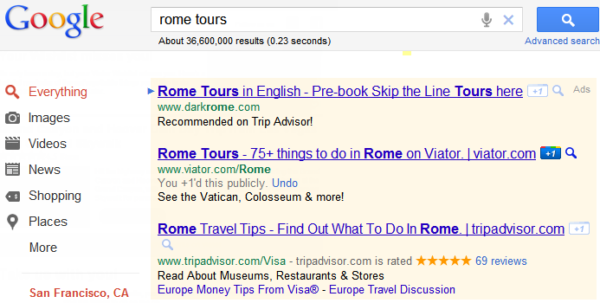+1 For The In-House Search Engine Marketer
After years of minimal change to the format of AdWords ads (some ad extensions are the only radical change), all paid search ads now have the +1 button right after the headline on their right side. How will this new social aspect impact paid search marketing? And what can in-house search marketers do now to […]
After years of minimal change to the format of AdWords ads (some ad extensions are the only radical change), all paid search ads now have the +1 button right after the headline on their right side. How will this new social aspect impact paid search marketing? And what can in-house search marketers do now to capitalize on these changes?
The +1 Potential
The most obvious speculation regarding the influence of +1 on paid search is that +1 counts will directly impact quality score. And similarly for organic search, that +1 counts will become a ranking factor.
Google has always been keenly interested in the wisdom of the crowd, and definitely click-through rate is a huge factor in determining quality score, a click is viewed as a positive action in favor of the ad. It’s not a huge leap to speculate that ads with more +1ing (a positive action) will in turn be valued more highly by Google than ads without.
Even if there is not a direct correlation between +1 counts and quality score, there may be an indirect impact. Searchers may well be inclined to click more on ads that have +1 counts than those that do not (or even other unpaid search results that do not).
Via increased click-through rates, quality scores may well rise. Greg Sterling’s article on Google +1 back in March notes this is anecdotally the case.
Important to note is that the +1 is more about the ultimate content, not the ad itself necessarily. +1ing on a page, a paid search result or an organic search result can be cumulative. So the +1 counts for an ad might reflect +1ing on the organic search result or on the website itself as well as the ad.
What’s An In-House Search Marketer To Do?
All AdWords accounts are opted in to have +1 displayed, though there is an option to opt out of displaying the +1 button for AdWords ads. At this point, marketers should probably not be opting out, not only would the possible +1 benefit be missed, but now is a great time to learn about how +1 will impact paid search advertising.
Opting out essentially makes a marketer blind to the possible benefits and negative impacts of +1, a smarter move is to participate initially and understand the impact on paid search campaigns before opting out.
No fees are charged for +1ing, it doesn’t count as a click. Google has said that search marketers will have access to information on +1 counts in reporting, but to date those reports are not yet available. As more campaign data is available for +1, in-house search marketers should monitor this with a similar zeal they apply to quality score.
Possibly the most critical action an in-house search marketer can take is to get +1 buttons added to their organization’s website. Because all the +1 information, paid or unpaid, on a website or in search results, is shared.
Theoretically, +1’ing a website’s page should increase the counts for the ad(s) that link to that page in addition to any possible SEO benefits. If there’s no +1 button the page, essentially one avenue for growing +1 counts is unavailable.
Within a paid search ad itself, it will probably not ultimately serve a campaign well to focus on +1ing as a call to action, but it would be interesting to test it as a part of a message if space allowed.
Additionally, I wouldn’t encourage +1 spam, but, particularly at this early stage, there may be no harm in reminding friends to +1 great paid search ads as they see them, particularly since there is no cost associated.
Keep Your Tracking On
Google is taking action to harmonize paid search URLs that often have tracking codes in them with the basic page URLs of the website to get a more accurate +1 count. This is great news for in-house marketers who rely on URL tracking parameters for search reports.
At this point, any tracking codes after a “?” in a URL string will not be used in determining unique URLs, so tracking parameters added via this common nomenclature should not be confounding +1 counts.
Hopefully More Answers Come
With any radical change to AdWords comes a myriad of questions. Kudos to Google for actually answering many of them upfront for the +1 release and encouraging a relative degree of transparency.
There are still some lingering +1 questions. Will the +1ing on the ad itself have a relative weight in terms of the paid ad versus the +1ing on a website page or an organic result? Also, will reports on the +1ing be available in AdWords or will it only be accessible in Webmaster Tools and Google Analytics?
Hopefully, more answers to come in the future as Google +1 picks up popularity and importance to in-house search marketers.
Contributing authors are invited to create content for Search Engine Land and are chosen for their expertise and contribution to the search community. Our contributors work under the oversight of the editorial staff and contributions are checked for quality and relevance to our readers. The opinions they express are their own.
Related stories
